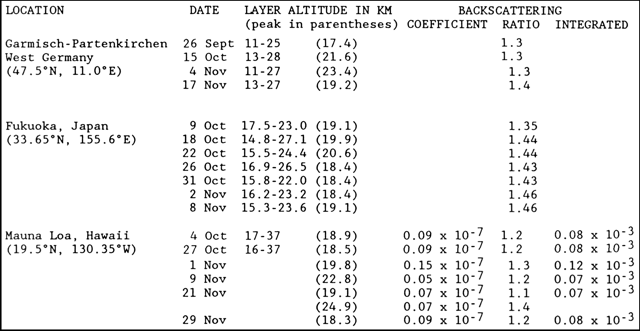Report on Atmospheric Effects (1980-1989) — November 1988

Atmospheric Effects (1980-1989)
Scientific Event Alert Network Bulletin, vol. 13, no. 11 (November 1988)
Managing Editor: Lindsay McClelland.
Atmospheric Effects (1980-1989) No new stratospheric injections
Please cite this report as:
Global Volcanism Program, 1988. Report on Atmospheric Effects (1980-1989) (McClelland, L., ed.). Scientific Event Alert Network Bulletin, 13:11. Smithsonian Institution.
Atmospheric Effects (1980-1989)
All times are local (unless otherwise noted)
Lidar stations in Germany, Japan, and Hawaii detected no apparent new stratospheric aerosol layers, and no recent large explosive eruptions have been reported. Substantially increased backscattering was measured between 17 and 22 km altitude at Mauna Loa, Hawaii on 1 November. Despite some instrument problems that night, the increased aerosols appeared real, but the profile did not have the characteristics of material from a new eruption.
Information Contacts: Thomas DeFoor, Mauna Loa Observatory, P.O. Box 275, Hilo, HI 96720 USA; Motowo Fujiwara, Physics Department, Fukuoka University, Jonan-ku, Fukuoka 814-01, Japan; Horst Jäger, Fraunhofer-Institut für Atmosphärische Umweltforschung, Kreuzeckbahnstrasse 19, D-8100 Garmisch-Partenkirchen, West Germany.

